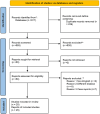Efficacy and safety of calcineurin inhibitors in cutaneous lupus: a systematic review and brief meta-analysis of recommended concentration, type, and outcomes
- PMID: 40337382
- PMCID: PMC12055059
- DOI: 10.1097/MS9.0000000000003047
Efficacy and safety of calcineurin inhibitors in cutaneous lupus: a systematic review and brief meta-analysis of recommended concentration, type, and outcomes
Abstract
Background: Establishing effective treatment for cutaneous lupus erythematosus (CLE) is of major importance given lack of approved medications for this autoimmune condition. Topical calcineurin inhibitors have been used to treat all types of CLE, yet there is currently no robust study that evaluated the efficacy of calcineurin inhibitors in this patient population. Our aim is to study the efficacy of topical calcineurin inhibitors for treating patients with CLE and assess the side effects associated with the use of this class of medications.
Materials and methods: A systematic review was conducted following the AMSTAR guidelines. A systematic search for articles published between 2003 and 2024 in PubMed, MEDLINE, the Cochrane library (Cochrane Databases of Systematic Reviews), and the Cochrane Register of Controlled Trials for relevant studies that assessed the efficacy of calcineurin inhibitors in patients with CLE.
Results: Twenty-five studies met the criteria, and we reviewed and collectively included. Based on the Quality assessment, some concerns are raised in the quality assessment of RCTs studies. However, Observational studies have high methodological quality.
Conclusion: In conclusion, our systematic review analyzed 25 studies to evaluate the efficacy and safety of topical calcineurin inhibitors in treating CLE. Our systematic review findings support the effectiveness of these inhibitors, namely pimecrolimus cream and tacrolimus ointment in improving clinical manifestations and disease activity in various forms of CLE, such as discoid lupus and subacute CLE. However, the result from RCTs metanalysis showed no significant difference between calcineurin inhibitors and other treatments. While calcineurin inhibitors are generally safe, the most common side effect was skin burning sensation at application site in the first few days of treatment. Further research is needed to prove the effectiveness of these drugs, explore the comparative effectiveness between different calcineurin inhibitors and comparing their types and their concentration.
Keywords: calcineurin inhibitors; cutaneous lupus erythematosus; discoid lupus; pimecrolimus; subacute LE; tacrolimus.
Copyright © 2025 The Author(s). Published by Wolters Kluwer Health, Inc.
Conflict of interest statement
Sponsorships or competing interests that may be relevant to content are disclosed at the end of this article. The authors declare they have no conflicts of interest.
Figures






Similar articles
-
Topical tacrolimus and pimecrolimus in the treatment of cutaneous lupus erythematosus: an evidence-based evaluation.Eur J Clin Pharmacol. 2008 Apr;64(4):337-41. doi: 10.1007/s00228-007-0421-2. Epub 2007 Dec 20. Eur J Clin Pharmacol. 2008. PMID: 18157526 Review.
-
Topical calcineurin inhibitors in systemic lupus erythematosus.Ther Clin Risk Manag. 2010 Apr 15;6:95-101. doi: 10.2147/tcrm.s3193. Ther Clin Risk Manag. 2010. PMID: 20421909 Free PMC article.
-
Management of cutaneous manifestations of lupus erythematosus: A systematic review.Semin Arthritis Rheum. 2020 Feb;50(1):95-127. doi: 10.1016/j.semarthrit.2019.07.010. Epub 2019 Aug 12. Semin Arthritis Rheum. 2020. PMID: 31526594
-
Interventions for cutaneous disease in systemic lupus erythematosus.Cochrane Database Syst Rev. 2021 Mar 9;3(3):CD007478. doi: 10.1002/14651858.CD007478.pub2. Cochrane Database Syst Rev. 2021. PMID: 33687069 Free PMC article.
-
Topical calcineurin inhibitors as a double-edged sword in rosacea: A systematic review.J Cosmet Dermatol. 2022 Apr;21(4):1695-1704. doi: 10.1111/jocd.14315. Epub 2021 Jul 10. J Cosmet Dermatol. 2022. PMID: 34192412
References
-
- Kuhn A, Aberer E, Bata-Cs Z, et al. . S2k guideline for treatment of cutaneous lupus erythematosus-guided by the European Dermatology Forum (EDF) in cooperation with the European Academy of Dermatology and Venereology (EADV). J Eur Acad Dermatol Venereol 2017;31:389–404. - PubMed
-
- Avgerinou G, Papafragkaki DK, Nasiopoulou A, et al. . Effectiveness of topical calcineurin inhibitors as monotherapy or in combination with hydroxychloroquine in cutaneous lupus erythematosus. J Eur Acad Dermatol Venereol 2012;26:762–67. - PubMed
-
- Tzellos TG, Kouvelas D. Topical tacrolimus and pimecrolimus in the treatment of cutaneous lupus erythematosus: an evidence-based evaluation. Eur J Clin Pharmacol 2008;64:337–41. - PubMed
-
- Wollina U, Hansel G. The use of topical calcineurin inhibitors in lupus erythematosus: an overview. J Eur Acad Dermatol Venereol 2008;22:1–6. - PubMed
LinkOut - more resources
Full Text Sources
Miscellaneous
